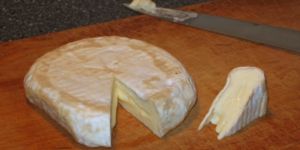Camembert
Camembert is an iconic French cheese made from cow's milk; it is, along with brie and roquefort, probably the most famous of the hundreds of cheeses made in France.[1] Soft and moderately flavored, with a downy rind,[2] the purest camemberts are made in the Normandy region[3] of France from raw, unskimmed, and unpasteurized milk. It falls into the general category of fromages à croûte fleurie, or white mold cheese. Although camembert is now produced all over France, only those cheeses that meet rigid government standards are allowed to be sold with the coveted A.O.C. (Appellation d'Origine Contrôlée) certification on them. Although similar cheeses had probably been made in the region for centuries earlier, it was only around 1790 that a local farmer's wife, Marie Harel, supposedly perfected the technique by which they are still made. [4] A statue in her honor has been erected in the small village of Camembert, financed, ironically, by an American admirer of the cheese.
The process of making camembert is similar to that employed for the larger and somewhat milder brie, but the micro-organisms of the two cheeses are different. "Like Brie", says the 1961 edition of the Larousse Gastronomique, "its crust must be a yellowish-orange without any black streaks. The cheese must be pale yellow, smooth and without holes. It must not be runny." [5] Today, however, with more standardized procedures in place and a better understanding of the mold process, a perfect camembert is now expected to have a mostly white rind. One authoritative cheese book says that, "The shape should be intact, and the rind covered in white mold, with reddish stripes and stains. The pâte should be creamy yellow, supple and give slightly to finger pressure. There should be a light smell of mold and the taste may be too salty at times. The locals prefer Camembert moitié affiné — half and half — when the filet or heart is still white and not yet creamy."[6] A perfect camembert is generally aged from two to three weeks by its maker, sold, then further aged by a fromager-affineur, a cheese specialist who has his own cellars with low temperatures and controlled levels of high humidity, for another few weeks in order to fully develop its own distinct characteristics. [7]
To obtain the A.O.C. certification, camemberts must be of a standard size (about nine and a half ounces) and must be made of raw, unfiltered, unheated milk that yields a finished cheese with a fat content of at least 38 percent. [8] The milk must come from cows in Normandy that have been fed under certain conditions [9] and must be ladled in four separate layers into round molds that are between 10 and 11 centimeters in depth.[10]
Total production of camembert in France in 2006 was 112,000 tons, most of it mass produced from pasteurized milk; only 12,000 tons made in the traditional process in Normandy were accorded the A.O.C. Today, the two largest producers of manufactured camembert, Lactalis and Isigny Sainte-Mère, are petitioning the National Institute for Origin and Quality to accord their cheeses A.O.C status in spite of their being produced with new techniques of "thermizing" and "microfiltration."
Because A.O.C. camemberts are aged less than 60 days, the Food and Drug Administration does not allow them to be imported into the United States; only those raw-milk cheeses that have been aged longer than two months can be imported. [11] Non-A.O.C. camemberts are also made in the United States and throughout the world.
References
- ↑ Charles de Gaulle is supposed to have asked, irascibly, "How can one govern a nation with 365 kinds of cheese?" Other sources use the figure of 246. The subtitle of the source French Cheeses is The visual guide to more than 360 cheeses from every region of France."
- ↑ Culinaria France, Culinaria Könemann, Cologne, English edition 1999, page 46
- ↑ Only in the départements of Calvados, Eure, Manche, Orne, and Seine-Maritime: Culinaria France, Culinaria Könemann, Cologne, English edition 1999, page 108
- ↑ Larousse Gastronomique, Paul Hamlyn, London, 1961 edition, page 237
- ↑ Larousse Gastronomique, Paul Hamlyn, London, 1961 edition, page 237
- ↑ French Cheeses, Eyewitness Handbooks, DK Publishing, New York, 1996, page 66
- ↑ Culinaria France, Culinaria Könemann, Cologne, English edition 1999, page 46
- ↑ New York Times, "Dining Out" section, "Corrections," pages D2, Wednesday, June 27, 2007
- ↑ New York Times article "If Rules Change, Will Camembert Stay the Same?", "Dining Out" section, pages D1 and D4, Wednesday, June 20, 2007 [1]
- ↑ The complete A.O.C. regulations for Normandy camemberts:
- Concentrated or powdered milk, lactic proteins, or coloring may not be added to the milk.
- The milk must not be heated above 98.6 degrees.
- The uncut curd must be sliced vertically.
- The curd must be cast with a ladle whose diameter corresponds to that of the mold: the operation is undertaken in stages, with a minimum of four successive fillings.
- Salting is carried out with dry salt exclusively.
- After salting, the cheeses are taken to the drying room, where the temperature is between 50 degrees F and 57 degrees F: they are left in wooden boxes. Before this, they may be placed on boards, in cellars at 46 or 48 degrees F.
- The words Fabrication traditionelle au lait cru avec moulage à la louche may appear on the label of a cheese benefiting from the A.O.C. Fabriqué en Normandie indicates the place of production on the labels of cheeses not benefiting from the A.O.C.
- All information above comes from French Cheeses, Eyewitness Handbooks, DK Publishing, New York, 1996, page 66.
- ↑ New York Times article "If Rules Change, Will Camembert Stay the Same?", "Dining Out" section, pages D1 and D4, Wednesday, June 20, 2007
